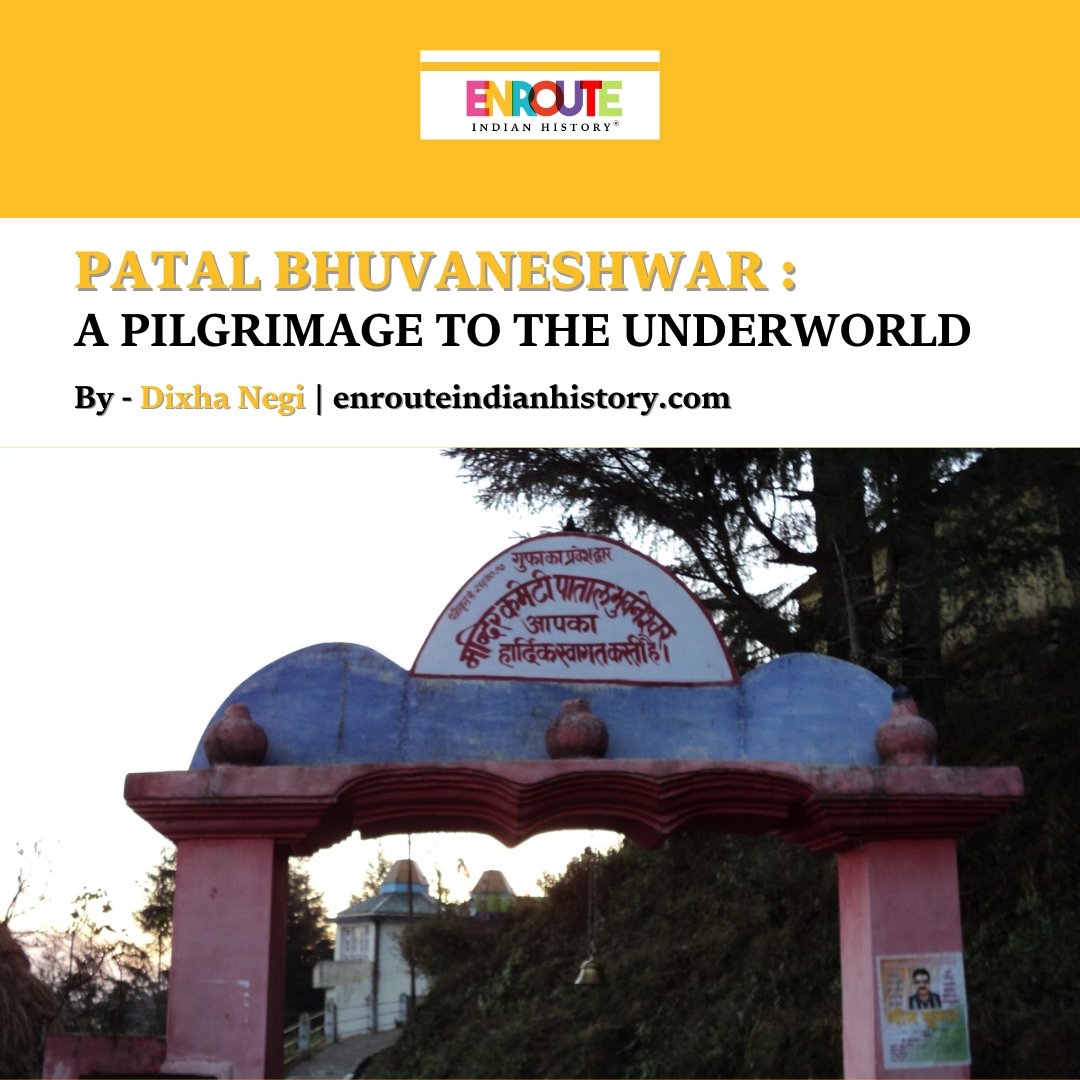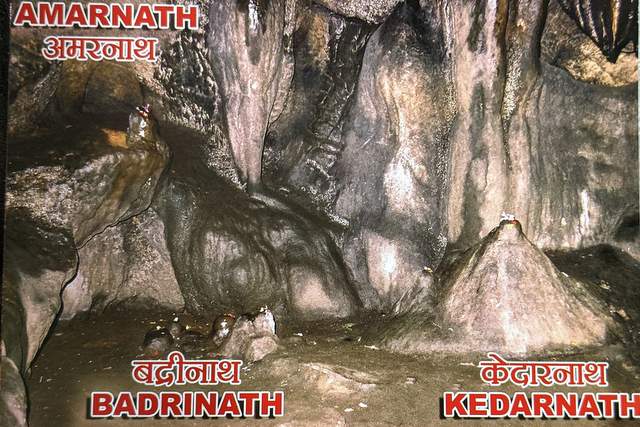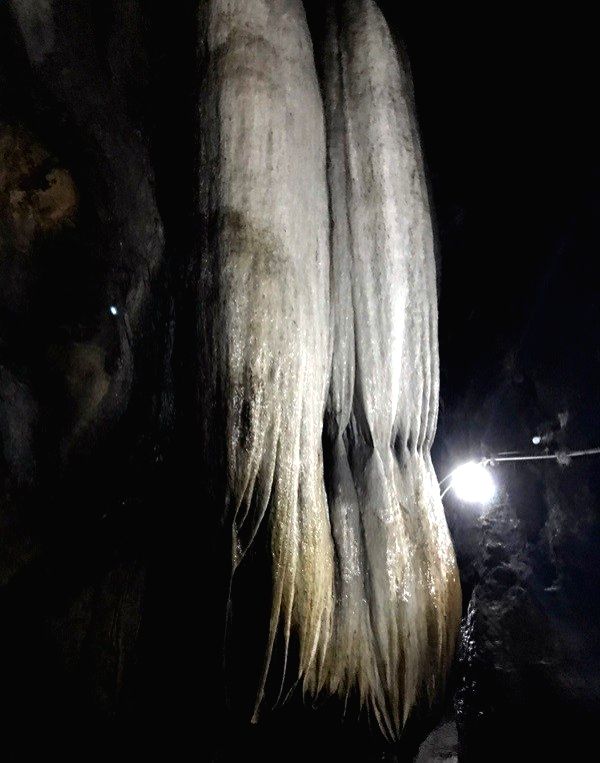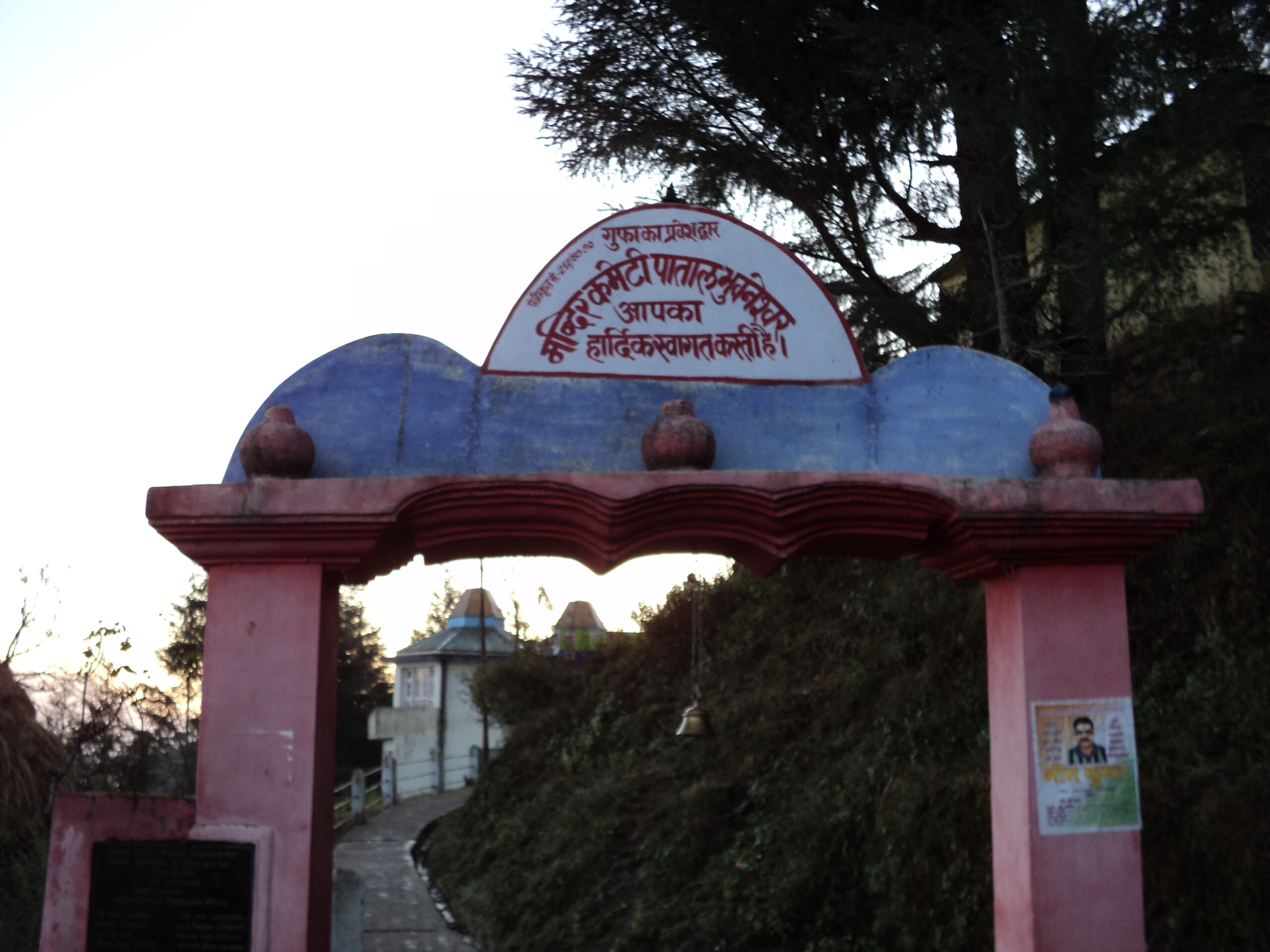
PATAL BHUVANESHWAR: A PILGRIMAGE TO THE UNDERWORLD
Article By – Dixha Negi
It was December and our family was all set for the long-awaited New Year’s break. We were staying at Chaukori a place characterized by snow-capped mountains, serene valleys, deodar trees and picturesque views. After spending an overnight, we decided on Patal Bhuvaneshwar. Imagine walking down an 800-meter path, its railings lined with temple bells. As you walk towards the temple entrance, the crowd with their heads adorned with red forehead bands and the festive decorations create a welcoming atmosphere, inviting you to embark on a spiritual pilgrimage. While I’ve visited many temples, this one stands out in terms of both curiosity and architecture. It’s a popular tourist attraction and remains shrouded in mystery, as many things remain unsolved.
Lying in the Himalayas, in Devbhoomi Uttarakhand, the entrance to this cave temple is approximately 20kms.away from Chaukori. Patal Bhuvaneshwar can be called an underground city, as it spreads its boundaries across 160m and at a depth of 90m. Believed to be a portal to the underworld, its intricate network of internal paths is said to connect sacred sites such as Kailash Mansarovar, Char Dham, Kashi, and Rameshwaram.
MYTHS AND LEGENDS
The Manas Khand of the Skanda Purana is a sacred text chronicling various legends and mythological tales. The tale of King Rituparna of the Surya Vansha is also one of many such tales. This ruler of Ayodhya is believed to have discovered the cave of Patal Bhuvaneshwar during the Treta Yuga. This textual reference adds to its authenticity and religious importance. The cave was rediscovered during the Dwapar Yuga by the Pandavas.
After their victory in the Kurukshetra War, the Pandavas and Draupadi embarked on a spiritual journey to find a way to attain eternal life. The Himalayas were believed to hold the secrets to immortality for many. During their quest, they stumbled upon the hidden entrance to Patal Bhuvaneshwar. This cave, believed to be a creation of Lord Shiva, was said to lead to the underworld and hold the secrets of life and death.
After their victory in the Kurukshetra War, the Pandavas and Draupadi embarked on a spiritual journey to find a way to attain eternal life. The Himalayas were believed to hold the secrets to immortality for many. During their quest, they stumbled upon the hidden entrance to Patal Bhuvaneshwar. This cave, believed to be a creation of Lord Shiva, was said to lead to the underworld and hold the secrets of life and death.
WHAT IS INSIDE PATAL BHUVANESHWAR?
SHESHNAAG
King Nala is a legendary king from Indian mythology, particularly in the epic Mahabharata, known for his prowess as a gambler and his eventual reunion with his beloved wife, Damayanti. He is often depicted as a righteous and virtuous king who, despite his gambling addiction, ultimately learns valuable lessons about life and love. His story is a popular theme in Indian literature and folklore. King Nala defeated by his wife Queen Damayanti, asked his friend, Rituparna, to hide him.
Rituparna took Nala to the Himalayan forests and left him there. On his way back, he was captivated by a deer and chased it into the woods. Lost and tired due to being unable to catch his prey, Rituparna rested under a tree and had a dream where the deer pleaded with him not to chase it. When he woke up, he discovered a cave and decided to explore. Having obtained permission from the guard, he entered the cave. Inside the cave, Rituparna met Sheshnag, the cosmic serpent, who agreed to carry him through the cave. Sheshnag took Rituparna on a journey through the cave, where he witnessed the grand spectacle of the 33-KOTI gods and goddesses, including Lord Shiva.
Sheshnaag, a major character in Hindu mythology, is a massive snake with numerous heads. This divine being plays a crucial role in upholding the cosmic order. Sheshnaag is believed to be the serpent upon whose hood the Earth rests, symbolizing its immense strength and role in sustaining the universe. The entrance of Patal Bhuvaneshwar is said to be located within the mouth of Sheshnaag.
As one enters the cave, they are greeted by a breathtaking sight of the limestone formation of Sheshnaag. The limestone formation, visible beneath the feet, resembles Sheshnaag’s skeletal formations. Its long, sharp fangs, etched into the stone, add to its imposing appearance.

Figure: Sheshnaag skeletal formations (Credits: Nainital Credits)
Vasuki and the Yagna Kund
The walls of Patal Bhuvaneshwar reveal a fascinating tale etched into the very stone. The impression of Vasuki, the thin, long snake that rests upon the shoulders of Lord Shiva, is visible, a testament to the cave‘s ancient history.
At the entrance, you’re greeted by the austere presence of a Hawan kund, a sacred fire pit used for ritual sacrifices. Legend has it that King Janamejaya, son of King Parikshit, performed a yagna at this very site. This yagna was undertaken as a vengeful act, seeking to kill all snakes on Earth and in the Patal Lok, in retaliation for the death of King Parikshit at the hands of a snake.
As you delve deeper into the cave, the scene becomes even more vivid. It’s as if you’re witnessing the Takshaka snake, poised to strike Janamejaya, just moments before the yagna begins. The tension is palpable, a reminder of the ancient conflicts and sacrifices that have shaped this sacred place.
ADI GANESH
On moving a bit further, one can view the limestone structure of Adi Ganesh. Adi Ganesh refers to the body of a child without its head. This unusual shape adds to the mystique and spiritual significance of the place.
Legend has it that the original form of Lord Ganesha after his head was severed, was preserved by the drops of water from the Brahmakamal flower. These divine drops kept the body alive until a suitable head was found to replace the lost one.
The presence of three holes on the surface of the structure, representing the spine, breath, and food, is a fascinating detail. These holes may symbolize essential life functions. The rock formation of a large Brahmakamal flower above the Adi Ganesh structure is a striking feature. The fact is that water regularly drips from the flower to nourish the structure below.
CHARDHAM AND AMBARNATH
As you venture deeper into the Patal Bhuvaneshwar cave, carved into the walls, you’ll find miniature cave structures accompanied by a naturally formed Shiva lingam. These miniature shrines are believed to represent the famous Hindu pilgrimage sites of Amarnath, Badrinath, and Kedarnath, revered Hindu deities. It’s believed that worshipping here is akin to paying homage to these renowned shrines, offering a divine shortcut for devotees seeking blessings.
Standing guard near these sacred idols is Kalabhairava, a fearsome yet protective deity, depicted with an open mouth and protruding tongue. This imposing figure adds to the mystical atmosphere of the cave.
The narrow passage leading through the cave is said to symbolize the journey a soul must take to attain moksha, the ultimate liberation from the cycle of birth and death. Devotees believe that by traversing this challenging path, they can pave the way for their spiritual liberation.

Figure: Miniatures of the Chardham and Amarnath formed from limestones (Credits: Nainital Tourism)
THE GATES
As you reach a critical juncture within the cave, you’re greeted by a captivating depiction of Lord Shiva, the Destroyer of the cosmos. Seated upon a majestic lion, adorned with a garland of skulls, Shiva’s powerful presence is undeniable. This image symbolizes his role as the ultimate force of destruction, capable of obliterating even the universe itself.
Beyond this lies four doors, each representing a specific attribute. These doors, named Ran Dwar (Door of War), Paap Dwar (Door of Sin), Dharam Dwar (Door of Righteousness), and Moksha Dwar (Door of Liberation), offer a glimpse into the spiritual journey of the soul.
Paap Dwar, the Door of Sin, was once a gateway to the underworld, open during the Treta Yuga. However, with the defeat of Ravana, this door was sealed, symbolizing the triumph of good over evil.
Ran Dwar, the Door of War, followed suit, closing after the epic battle of Kurukshetra in the Dwapar Yuga. This event marked the end of a chaotic period and signalled the beginning of a new age.
At the dawn of Kali Yuga, a new door was revealed: Moksha Dwar, the Door of Liberation. This gateway to spiritual enlightenment opened again, offering a path to salvation for those seeking to escape the cycle of birth and death.
Dharam Dwar, the Door of Righteousness, will open at the end of Kali Yuga, the current age of darkness and strife. This event will herald a new era, one characterized by righteousness and spiritual awakening. Finally, Moksh Dwar, the Door of Liberation, will stand as the sole gateway in the subsequent Satya Yuga, an age of perfect harmony and spiritual enlightenment.
Shiv Jata
Deeper into the Patal Bhubneshwar cave, the icy embrace becomes more pronounced. The floor, slick and treacherous, is a testament to the cave’s eternal chill. Suddenly, a breathtaking sight emerges a frozen sculpture, a chilling yet awe-inspiring representation of Lord Shiva’s Jata, his flowing hair. The upper portion of the Jata is encased in a frozen sheath, a testament to the cave’s extreme temperatures. The lower half, however, is composed of a softer, limestone formation, contrasting beautifully with the icy crown above.
Beneath this frozen masterpiece lies a naturally formed Shiva Lingam, surrounded by the depictions of 33 koti (types) of Hindu gods. A small, crystalline pond, believed to have been created by the divine architect Vishwakarma, adds to the sacred ambience. The rock formation of Vishwakarma’s hand, a tangible reminder of his presence, stands beside the pond.

Figure: Shiva Jata (Credits: Nainital Tourism)
CAVE OF RISHI MARKANDEYA
Peering into one of the caves, you might be surprised to see the faint outline of a figure seated in Padmasana, the lotus posture of meditation. According to local lore, this is the subtle body of Rishi Markandeya, a revered sage who spent countless hours meditating within these sacred walls.
Continuing your journey, you’ll come across the legendary battlefield where Hanuman and Ahiravan, the demon king, clashed in an epic battle. The echoes of their confrontation still linger in the air, adding to the mystical atmosphere.
Venturing further into the cave, you’ll discover an inner chamber where the Markandeya Purana, a sacred Hindu scripture, is believed to have been composed. This sacred space is imbued with the spiritual energy of the sage who penned these divine words.

Figure: Patal Bhuvaneshwar (Credits: Wikimedia Commons)
Patal Bhuvaneshwar, a subterranean marvel nestled within the Himalayas, offers a captivating blend of mythology, history, and natural beauty. Its intricate network of tunnels, adorned with ancient carvings and sacred formations, invites visitors on a journey through time and spirituality. The cave’s association with various Hindu legends and scriptures adds to its religious significance.
Beyond its mythological and historical significance, Patal Bhuvaneshwar offers a unique opportunity for spiritual reflection and exploration. The cave’s serene atmosphere and the intricate carvings on its walls create a powerful ambience that can inspire introspection and a deeper connection to the divine.
Patal Bhuvaneshwar can be interpreted as a symbol of the human soul’s journey through life. The cave’s winding passages may represent the challenges and obstacles we encounter on our path. The various shrines and deities within the cave can be seen as guiding forces and spiritual protectors.
Ultimately, it is a place of wonder and inspiration, a testament to the enduring power of mythology and the beauty of the natural world. Whether you visit as a spiritual seeker, a history enthusiast, or simply a lover of adventure, this underground marvel is sure to leave a lasting impression.
REFERENCES AND IMAGES
Goyal, A. (2023). Patal Bhuvaneshwar: Underground Cave City In Kumaon – Inditales. [online] Inditales. Available at: https://www.inditales.com/patal-bhuvaneshwar-underground-cave-city-kumaon/ [Accessed 30 Sep. 2024].
dass, param (2018). Patal Bhuvaneshwar Cave in Uttarakhand – History, Best Time to Visit. [online] Chardham Yatra. Available at: https://www.chardhamtour.in/patal-bhuvaneshwar.html [Accessed 30 Sep. 2024].
Resham Sengar (2019). The ancient Patal Bhuvneshwar cave in Uttarakhand is as mysterious as it can get. [online] Times of India Travel. Available at: https://timesofindia.indiatimes.com/travel/destinations/the-ancient-patal-bhuvneshwar-cave-in-uttarakhand-is-as-mysterious-as-it-can-get/articleshow/72334575.cms [Accessed 30 Sep. 2024].
Images from Wikimedia Commons and Nainital Tourism. (Public Domain)



















